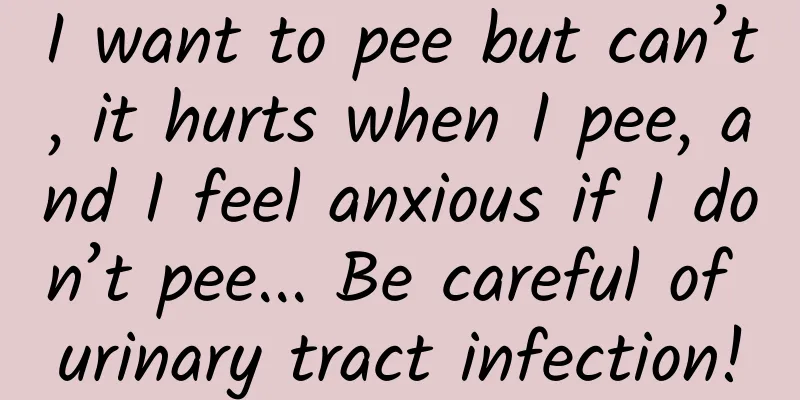I want to pee but can’t, it hurts when I pee, and I feel anxious if I don’t pee... Be careful of urinary tract infection!

|
Talking about urinary tract infection I believe everyone has tightened their grip. The feeling of wanting to urinate but not being able to, and feeling pain when urinating No urination, panic It may even cause fever, hematuria, and back pain . The experience is simply not good enough Especially female friends Due to the differences in physiological structure It is more likely to happen to women than men. Repeated recurrence It's also tight and the urinary tract infection won't heal ! Urinary tract infection is an acute or chronic inflammation of the urinary tract caused by abnormal reproduction of various pathogens (mainly bacteria, but also some rare fungi, mycoplasma, chlamydia or tuberculosis bacteria, etc.) in the urinary system. Image source: Photo Network For example: When bacteria enter the urethra and reach the bladder, a bladder infection, commonly known as " cystitis ," occurs. When the bacteria travel up to the kidneys, a kidney infection, also known as " pyelonephritis ," occurs. Although urinary tract infection does not 100% show symptoms, you should be alert when these symptoms appear : Symptoms of a bladder infection Dysuria: Pain or burning sensation when urinating. Frequent urination: You feel the urge to urinate every once in a while, but you only urinate a little each time. Urinary urgency: The need to urinate suddenly or urgently, with the feeling that you may not be able to urinate and may pee in your pants at any time. Hematuria: The color of urine changes to red, bright pink, or bright red. Image source: Photo Network Symptoms of a kidney infection Symptoms of a kidney infection are more serious. In addition to symptoms associated with a bladder infection, you may also experience: Chills and fever; Low back pain Symptoms such as nausea and vomiting. Bladder infections are more common than kidney infections . Image source: Photo Network Moreover, urinary tract infection is a very biased disease. Although no one, young or old, male or female, dares to say with 100% certainty that they will not suffer from urinary tract infection in their lifetime, the key point is: women are more likely to suffer from it! Studies show that approximately 1 in 10 women suffers from a urinary tract infection every year ! But there is no solution to this problem, because women are physiologically destined to be more susceptible to urinary tract infections than men. Reason 1: Physiological structure The female urethra is shorter and wider than the male urethra, and is closer to the anus , making it easier for bacteria to reach the bladder and cause infection. Reason 2: Contraceptives Things like spermicides, condoms, and oral contraceptives can all trigger urinary tract infections. Reason 3: Pregnancy susceptibility factors Increased secretion of progesterone during pregnancy leads to weakened ureteral peristalsis. The enlarged uterus in late pregnancy can also compress the urinary tract, causing poor urine flow and increasing the risk of urinary tract infection. Image source: Photo Network Reason 4: Postmenopausal susceptibility factors Postmenopausal estrogen deficiency causes changes in vaginal flora, decreased local resistance , and increased likelihood of infection. If you experience frequent urination, urgent urination, painful urination, etc., do not just take anti-inflammatory drugs or antibiotics on your own. After all, there are other diseases that may also cause similar symptoms. Therefore, you must go to a regular hospital to seek the help of a specialist, assess the condition, make a clear diagnosis, and standardize treatment . Commonly used examination methods are: Image source: Photo Network Routine urine test: bacteria, white blood cells, and even pus cells can be found in urine; Routine blood tests and C-reactive protein: If white blood cells, neutrophils, and C-reactive protein are found to be elevated, it indicates bacterial infection; Urine culture: can identify infectious pathogens; Urinary tract ultrasound: Mainly used to screen for combined renal cysts, stones, urinary tract anatomical malformations, etc. Special circumstances may require other more complex examinations to detect the cause of the infection and special pathogens , such as mycoplasma and fungi. Depending on the condition of the urinary tract infection, treatment often requires antibiotics to kill the bacteria that cause the infection ; For example , bladder infections usually require antibiotics for 3-7 days ; complicated bladder infections and kidney infections often require at least 2 weeks of antibiotic treatment , and patients with severe symptoms may need hospitalization . In addition, you need to increase your water intake to help flush out the bacteria . Image source: Photo Network Of course, the treatment of urinary tract infection varies greatly depending on the condition. It is better to leave this matter to a professional to judge, and never take medicine on your own! ● Drink more water, urinate frequently , and don't hold your urine easily. This is a very effective prevention method; ● After urinating or defecating, the perineum must be wiped from front to back , not from back to front; ● Pay attention to hygiene, wash the perineum with warm water every day, and change underwear every day ; ● Take a shower instead of a bathtub; ● Choose a contraceptive method that does not increase the risk of urinary tract infections and avoid using spermicides ; ● Urine immediately after intercourse . See here Do you still hold your urine? Welcome to share your story in the comment section ~ Statement: This article is a medical-related educational popular science article. It does not involve specific treatment methods or medical behaviors and cannot replace hospital visits. Experts collaborating on this article References 1. Chinese expert consensus on the diagnosis and treatment of urinary tract infections in women (2017); Patient education: Urinary tract infections in adults (The Basics). UpToDate Clinical Consultant. Content Production Editor: Yang Yali Map: Eastern Zhou Dynasty |
<<: The high-sounding sound of "gold" is most likely not real gold!
Recommend
Pinduoduo’s new e-commerce operation methodology!
Today, Pinduoduo released its Q4 and full-year fi...
When information flow copywriting has been overused, how can you stand out and make users’ eyes light up?
Before we get into the topic, let’s look at a cas...
Famous Ships in Chinese History (VIII)
Today I would like to introduce to you the first ...
Can “Glucosamine” really save your joints, or is it just a waste of money?
A friend told Huazi that her mother had severe kn...
Methodology in the Internet Age: Learn hand-to-hand combat from Luo Yonghao
The first article in the series of methodology in...
How to start campus promotion and marketing from scratch?
The school season is about to begin, and the camp...
Why are programmers a little weird?
[[163850]] I have been a programmer for n years a...
Copywriting skills: 16 common UI copywriting mistakes
There are many techniques in copywriting design, ...
This generalized inverse matrix was reinvented by Penrose at the age of 24 | N-word rough linear algebra
Many students feel confused and painful when they...
10 Observations on E-commerce Marketing in 2020
This article, which contains 10 observations for ...
Roborock G10 self-cleaning sweeping and mopping robot: automatic backwashing, freeing your hands, you just need to press start
If you ask what consumers care about most today, ...
An excellent whole grain that is seriously neglected. It is delicious, not fattening, and can control blood sugar! It can replace rice and steamed buns
When you mention highland barley, the first thing...
It's outrageous: I'm 165cm tall and weigh 80kg, but I have fatty liver...
During the physical examination at the end of the...
World Water Day丨How to love and protect water?
How much water should a person drink a day? Today...









